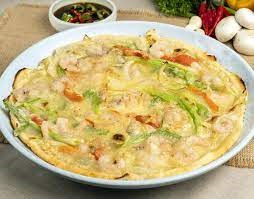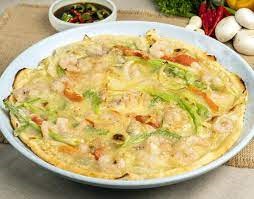Korean cuisine is renowned for its rich flavors, diverse ingredients, and unique dishes that have gained popularity worldwide. One such culinary delight is Haemul Pajeon (해물파전), a savory seafood pancake that offers a mouthwatering combination of flavors and textures. In this comprehensive blog post, we will delve into the history, various types, benefits, storage methods, recipes, and more, surrounding Haemul Pajeon. So, let’s embark on a flavorful journey to explore this delectable Korean dish.
History of Haemul Pajeon (해물파전)
Haemul Pajeon, a staple of Korean cuisine, has a rich history dating back centuries. The term “Haemul” translates to “seafood,” while “Pajeon” refers to “pancake.” This dish is believed to have originated during the Joseon Dynasty (1392-1910), making it a part of Korea’s culinary heritage.
During this era, Korean cuisine was heavily influenced by Confucianism, which emphasized frugality and resourcefulness in using ingredients. Haemul Pajeon perfectly embodied these principles by incorporating a variety of ingredients, particularly seafood, into a simple yet satisfying pancake.
Traditionally, Haemul Pajeon was prepared during festivities and celebrations, such as the Korean Lunar New Year (Seollal) and Chuseok (Korean Thanksgiving). It was a way to showcase the abundance of fresh seafood and vegetables available during these seasons. Over time, Haemul Pajeon evolved, adapting to regional preferences and ingredient availability.

Various Types of Haemul Pajeon
Haemul Pajeon is incredibly versatile, and there are several regional and seasonal variations of this beloved dish:
- Haemul Pajeon: The classic version typically includes a mix of various seafood like shrimp, squid, and mussels, combined with scallions and a savory batter.
- Kimchi Haemul Pajeon: Kimchi lovers rejoice! This version incorporates kimchi into the batter, creating a delightful fusion of flavors.
- Saengseon Haemul Pajeon: Saengseon means “fresh fish,” and this variety features slices of fresh fish alongside the usual seafood and scallions.
- Yachae Pajeon: For those who prefer a vegetarian option, Yachae Pajeon contains a medley of vegetables, such as zucchini, mushrooms, and bell peppers, in place of seafood.
- Hobak Pajeon: This version highlights the sweetness of Korean pumpkin (hobak) combined with scallions for a unique and slightly sweet twist.
- Dongnae Pajeon: A regional specialty from the Dongnae district in Busan, this variation uses a thin batter and is often served with a soy dipping sauce.
Recommended: Japchae (잡채): A Delicious Journey into Korean Cuisine
Benefits of Haemul Pajeon
Haemul Pajeon offers a range of benefits that go beyond its delicious taste:
- Rich in Protein: The seafood and eggs in Haemul Pajeon provide a substantial amount of protein, making it a satisfying and nutritious meal.
- Abundance of Vitamins and Minerals: The inclusion of scallions and various vegetables ensures that you get a dose of essential vitamins and minerals, including vitamins A, C, and K.
- Digestive Benefits: The fermentation process of kimchi in Kimchi Haemul Pajeon can promote gut health by introducing probiotics into your diet.
- Versatility: Haemul Pajeon can be customized to suit dietary preferences, including vegetarian options, making it accessible to a wide range of eaters.
- Cultural Experience: Trying Haemul Pajeon allows you to connect with Korean culture and appreciate its culinary traditions.
Now that we’ve explored the history, types, and benefits of Haemul Pajeon, let’s delve into some practical aspects of this dish.
How to Store Haemul Pajeon
Storing Haemul Pajeon is relatively straightforward, but it’s essential to maintain its flavor and texture:
- Refrigeration: If you have leftovers, wrap the Haemul Pajeon in plastic wrap or aluminum foil and store it in the refrigerator. Consume it within 2-3 days for the best taste.
- Freezing: Haemul Pajeon can be frozen for longer storage. Place individual pieces on a baking sheet and freeze until firm. Once frozen, transfer them to an airtight container or freezer bag, separating each piece with parchment paper. Frozen Haemul Pajeon can be reheated in the oven for a crispy texture.
- Reheating: To reheat refrigerated or frozen Haemul Pajeon, use an oven or toaster oven for the best results. Preheat to 350°F (175°C) and bake until heated through and crispy.
Must Read: Tteokbokki (떡볶이): A Delicious Journey into Korean Street Food
Recipes of Haemul Pajeon
Classic Haemul Pajeon Recipe
Ingredients:
- 1 cup all-purpose flour
- 1 cup ice-cold water
- 1 egg
- 1/2 tsp salt
- 1 cup mixed seafood (shrimp, squid, mussels)
- 4-5 stalks green onions, cut into 2-inch pieces
- Vegetable oil for frying
- Soy dipping sauce (soy sauce, vinegar, sugar, red pepper flakes)
Instructions:
- In a mixing bowl, combine flour, ice-cold water, egg, and salt. Mix until you have a smooth batter.
- Heat a non-stick skillet or pan over medium-high heat. Add a generous amount of vegetable oil.
- Pour the batter into the skillet to create a pancake. Quickly spread it out to form an even layer.
- Place the mixed seafood and green onions on top of the pancake.
- Cook until the edges become crispy and golden brown, about 3-4 minutes. Flip it over and cook the other side until it’s crispy as well.
- Serve hot with soy dipping sauce.
What to Do with Haemul Pajeon (해물파전)
Haemul Pajeon is incredibly versatile and can be enjoyed in various ways:
- Main Course: Serve it as a main dish with a side of rice and dipping sauce.
- Appetizer: Cut it into bite-sized pieces and serve it as an appetizer at parties or gatherings.
- Street Food: Haemul Pajeon is a popular street food in South Korea, often served in bustling markets.
- Fusion Cuisine: Get creative by incorporating it into fusion dishes like tacos or sandwiches.
See Also: Sundubu Jjigae (순두부찌개): The Delights Of Korean Cuisine
What to Cook with Haemul Pajeon
- Kimchi Pancake: Make a spicy kimchi pancake by adding chopped kimchi to the batter before frying.
- Soy Dipping Sauce: Pair Haemul Pajeon with a traditional soy dipping sauce made with soy sauce, vinegar, sugar, and red pepper flakes.
- Pickled Radishes: Serve it with pickled radishes (danmuji) to balance the flavors.
- Seaweed Salad: Create a refreshing seaweed salad to complement the pancake’s richness.
How to Make Haemul Pajeon
Making Haemul Pajeon at home is relatively simple. Follow these steps for a delicious homemade version:
- Prepare the Batter: Mix flour, ice-cold water, egg, and salt in a bowl until you have a smooth batter.
- Heat the Skillet: Heat a non-stick skillet or pan over medium-high heat and add vegetable oil.
- Fry the Pancake: Pour the batter into the skillet, spread it out evenly, and add seafood and green onions on top.
- Cook Until Crispy: Cook until the edges become crispy and golden brown, then flip the pancake and cook the other side until it’s crispy.
- Serve: Slice and serve hot with soy dipping sauce.
Must Read: Lunch Sushi & Korean Special
Haemul Pajeon (해물파전) Ingredients
The ingredients for Haemul Pajeon typically include:
- All-purpose flour
- Ice-cold water
- Egg
- Salt
- Mixed seafood (shrimp, squid, mussels)
- Green onions
- Vegetable oil for frying
- Soy dipping sauce (soy sauce, vinegar, sugar, red pepper flakes)
Nutrition in Haemul Pajeon
The nutritional content of Haemul Pajeon can vary depending on the exact ingredients and portion size. However, here’s a general idea of its nutritional profile:
- Calories: Approximately 200-250 calories per serving
- Protein: 10-15 grams per serving
- Carbohydrates: 20-25 grams per serving
- Fat: 10-15 grams per serving
- Fiber: 1-2 grams per serving
- Vitamins: Contains vitamins A, C, and K from green onions
- Minerals: Provides calcium and potassium from green onions
See Also: Italian Seafood Dishes
FAQs
- Can I make Haemul Pajeon gluten-free? Yes, you can use gluten-free flour to make a gluten-free version of Haemul Pajeon.
- What other ingredients can I add to Haemul Pajeon? You can get creative and add ingredients like kimchi, vegetables, or even meat for a unique twist.
- Can I use frozen seafood for Haemul Pajeon? Yes, you can use frozen seafood, but make sure to thaw and drain it thoroughly before adding it to the batter.
- Is Haemul Pajeon vegan-friendly? Traditional Haemul Pajeon contains seafood and eggs, but you can explore vegan versions by using plant-based ingredients.
Conclusion
Haemul Pajeon (해물파전) is a delightful Korean dish that brings together the savory goodness of seafood and the freshness of green onions. Its rich history, versatility, and nutritional benefits make it a favorite among food lovers. Whether you savor it as a main course, appetizer, or street food, Haemul Pajeon is sure to tantalize your taste buds with its crispy, savory goodness. So why not try making it at home or exploring the diverse world of Korean cuisine to discover this hidden gem for yourself?
Recommended: Dishes that can be made using Leftover Food

